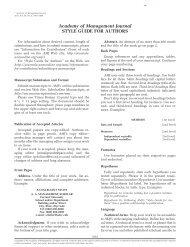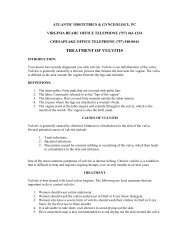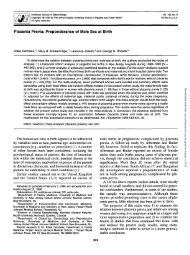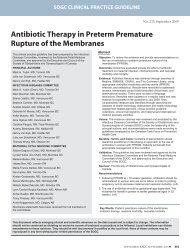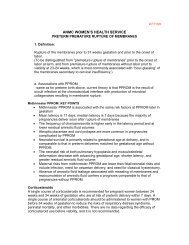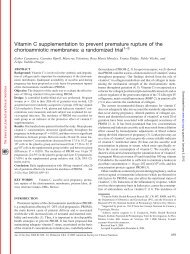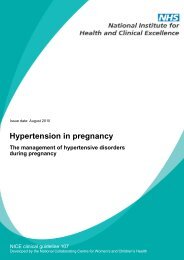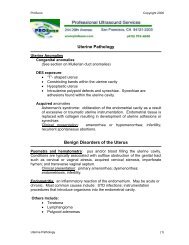Shoulder Dystocia
Shoulder Dystocia
Shoulder Dystocia
Create successful ePaper yourself
Turn your PDF publications into a flip-book with our unique Google optimized e-Paper software.
Obstetric emergencies<br />
<strong>Shoulder</strong> <strong>Dystocia</strong><br />
Definition:<br />
<strong>Shoulder</strong> dystocia is an acute obstetric emergency, which<br />
requires immediate, skilled intervention to avoid serious<br />
fetal morbidity or mortality. It occurs when the anterior<br />
shoulder becomes impacted against the symphysis pubis or<br />
the posterior shoulder becomes impacted against the sacral<br />
promontory. Anterior impaction tends to be more common,<br />
but infrequently, both anterior and posterior impaction can<br />
occur. This results in a bony dystocia and any traction that<br />
is applied to the baby will only serve to further impact the<br />
baby’s shoulder(s), impeding efforts to accomplish delivery<br />
(Arulkumaran et al 2003, Coates 2003, Tiran 2003,<br />
RCOG 2005).<br />
There can be high perinatal morbidity and mortality<br />
associated with the complication, even when it is managed<br />
appropriately (Gherman et al 1998). Consequently, the<br />
Royal College of Obstetricians and Gynaecologists (RCOG)<br />
and the Royal College of Midwives (RCM) jointly<br />
recommend annual obstetric skills drills, which include<br />
training in the management of shoulder dystocia (RCOG,<br />
RCM 1999, RCOG 2005).<br />
Causes:<br />
The incidence of shoulder dystocia has reportedly increased<br />
over the past few decades; the reasons for this being linked<br />
to increased fetal size (macrosomia) along with greater<br />
attention to documentation of such occurrences (Leveno<br />
et al 2007). While increased birth weight is the main cause<br />
of shoulder compaction, it is not uncommon in babies of<br />
birth weights < 4000g (Arulkuraman et al 2003, Leveno<br />
et al 2007). While it may be possible to be alert to, or<br />
anticipate, the possibility of shoulder dystocia where a<br />
vaginal birth is planned, management by caesarean section<br />
might be considered appropriate in some women (Leveno<br />
et al 2007). However, diagnosis can only be made at the<br />
point where impaction occurs and then urgent and skilled<br />
management is required to reduce the likelihood of<br />
negative outcomes (Leveno et al 2007).<br />
Incidence:<br />
True shoulder dystocia (where obstetric manoeuvres are<br />
required to facilitate delivery of the shoulders, rather than<br />
delivery of the body just being delayed) occurs in<br />
approximately 1:200 births (Arulkumaran et al 2003).<br />
Risk factors linked with shoulder dystocia:<br />
Antenatal<br />
●<br />
●<br />
●<br />
●<br />
Post-term pregnancy<br />
High parity<br />
Previous history of shoulder dystocia<br />
Previous large babies<br />
Obstetric emergencies / <strong>Shoulder</strong> <strong>Dystocia</strong> 01
Obstetric emergencies <strong>Shoulder</strong> <strong>Dystocia</strong><br />
● Normal birth manoeuvres fail to accomplish<br />
Failure of the presenting shoulder to descend<br />
● Maternal obesity (weight > 90kgs at delivery)<br />
● pushed in the direction of the fetal chest,<br />
● Maternal age over 35 years<br />
delivery of the baby (Arulkumaran et al 2003,<br />
Coates 2003, RCOG 2005).<br />
● Maternal diabetes and gestational diabetes<br />
● Excessive weight gain in pregnancy<br />
Management:<br />
● Clinically large baby/symphysis-fundal height<br />
[See Table 1 - The HELPERR mnemonic]<br />
measurement larger than dates<br />
●<br />
● Fetal growth > 90th centile on ultrasound scan<br />
Call for urgent medical assistance – obstetrician,<br />
obstetric anaesthetist, neonatologist, senior<br />
(fetal macrosomia) (Arulkumaran et al 2003,<br />
midwife.<br />
Coates 2003, CEMACH 2006).<br />
● Keep calm. Try to explain and reassure the<br />
While these factors have been associated with an increased<br />
woman and her partner as much as possible, to<br />
ensure full cooperation with the manoeuvres that<br />
risk of shoulder dystocia, the poor predictive value of<br />
may be needed to deliver.<br />
antenatal risk factors has also been identified<br />
● Fundal pressure should not be applied, as it is<br />
(Gherman 2002).<br />
associated with a high incidence of neonatal<br />
Intrapartum<br />
complications and can result in uterine rupture<br />
(RCOG 2005).<br />
● Birthing in a semi-recumbent position on a bed<br />
● Place the woman in the McRobert’s position, so<br />
can restrict movement of the sacrum and coccyx<br />
that she lies flat with her legs slightly abducted<br />
(McGeown 2001)<br />
and hyperflexed at 45 o to her abdomen– this<br />
● Prolonged labour, notably protracted late first<br />
stage (usually between 7–10cm) with a cervix<br />
that is loosely applied to the presenting part<br />
position will rotate the angle of the symphysis<br />
pubis superiorly, helps flatten the sacral<br />
promontory, increase the diameter of the pelvic<br />
● Oxytocin augmentation<br />
outlet and release pressure on the anterior<br />
shoulder. The McRobert’s manoeuvre is<br />
● Prolonged second stage<br />
associated with the lowest level of morbidity<br />
● Mid-pelvic instrumental delivery<br />
(Coates 2003) and has a success rate over 40%,<br />
which increases to over 50% when suprapubic<br />
pressure is also applied (Baxley 2003).<br />
● Apply firm, directed, supra-pubic pressure to the<br />
Warning signs that are associated<br />
side of the fetal back, pushing towards the fetal<br />
chest. This reduces the bi-sacromial diameter, and<br />
with impaction:<br />
can help to adduct the shoulders, pushing the<br />
● The fetal head may have advanced slowly<br />
anterior shoulder away from the symphysis pubis.<br />
● Difficulty in sweeping the face and chin over<br />
● Evaluate the need for an episiotomy, which can<br />
the perineum<br />
assist manipulations and gain access to the baby<br />
without tearing the perineum and vaginal walls<br />
● Once delivered, the head may give the<br />
(RCOG 2005, Leveno et al 2007).<br />
appearance of trying to return into the vagina<br />
● Apply gentle traction on the fetal head towards<br />
(reverse traction or ‘Turtle neck‘ sign)<br />
the longitudinal axis of the fetus, not strong<br />
● Once head delivered, baby’s cheeks appear ‘rosy<br />
and fat’, suggesting a large baby (common with<br />
downward traction which can damage the<br />
cervical spinal cord.<br />
maternal diabetes)<br />
● The Rubin’s manoeuvre can be used, which<br />
● Failure of restitution of the fetal head<br />
requires the practitioner to identify the posterior<br />
shoulder on vaginal examination. This is then<br />
prgmea.com<br />
Obstetric emergencies / <strong>Shoulder</strong> <strong>Dystocia</strong> 02
Obstetric emergencies <strong>Shoulder</strong> <strong>Dystocia</strong><br />
●<br />
●<br />
●<br />
thereby rotating the anterior shoulder away from<br />
the symphysis pubis. This manoeuvre reduces the<br />
12cm bi-sacromial diameter.<br />
The Wood’s (screw) manoeuvre can be applied to<br />
rotate the baby’s body so that the posterior<br />
shoulder moves anteriorly. This requires the<br />
practitioner to insert their hand into the woman’s<br />
vagina and identify the fetal chest. By applying<br />
pressure onto the posterior fetal shoulder,<br />
rotation is achieved. The Wood’s manoeuvre will<br />
abduct the shoulders, but enables them to rotate<br />
into a more favourable diameter for delivery.<br />
Delivery on all-fours may make delivery of an<br />
impacted shoulder easier (Arulkumaran<br />
et al 2003).<br />
Delivery of the posterior arm and shoulder can be<br />
attempted by inserting the hand into the small<br />
space created by the hollow of the sacrum. This<br />
allows the practitioner to flex the posterior arm<br />
at the elbow and then sweep the forearm over<br />
the baby’s chest. Once the posterior arm has<br />
been brought down, space becomes available<br />
and the anterior shoulder slips behind the<br />
symphysis pubis enabling delivery.<br />
Should all of these manoeuvres fail to accomplish<br />
delivery, the obstetrician may consider using the<br />
Zavanelli manoeuvre as an all-out attempt to<br />
deliver a live baby. This manoeuvre requires the<br />
reversal of the mechanisms of delivery so far and<br />
reinsertion of the fetal head into the vagina.<br />
Prompt delivery by caesarean section is then<br />
required; however this manoeuvre has a variable<br />
success rate (Arulkumaran et al 2003, Coates<br />
2003, Tiran 2003).<br />
Where the role of the midwife<br />
is to assist those undertaking<br />
the above manoeuvres, they<br />
should also, where possible,<br />
maintain an accurate and<br />
detailed record of those in<br />
attendance, the manoeuvre(s)<br />
used, the time taken and<br />
force of traction applied, and<br />
the outcome(s) of each<br />
manoeuvre attempted. The<br />
RCOG have suggested a<br />
proforma which can assist<br />
with this (Coates 2003, RCOG 2005). The RCOG suggest<br />
recording the following details:<br />
●<br />
●<br />
●<br />
●<br />
●<br />
Time of delivery of the head<br />
Direction of head after restitution<br />
Time of delivery of the body<br />
Condition of infant (APGAR, paired cord blood<br />
pH recordings)<br />
What time attending staff arrived, including<br />
names and designation<br />
Maternal complications:<br />
●<br />
●<br />
●<br />
Postpartum haemorrhage (approximately<br />
two-thirds will have a blood loss >1000 ml)<br />
(Benedetti & Gabbe 1978)<br />
Soft tissue trauma<br />
Third or fourth degree perineal tears (extension<br />
of episiotomy)<br />
Fetal and neonatal complications:<br />
●<br />
●<br />
●<br />
Fetal hypoxia or neonatal asphyxia – potential<br />
for neurological damage<br />
Brachial plexus injury – Erb’s Palsy/Klumpke’s<br />
paralysis (Tiran 2003)<br />
Fractures to the clavicle or humerus<br />
● Intrapartum fetal death (Coates 2003).<br />
Obstetric emergencies / <strong>Shoulder</strong> <strong>Dystocia</strong> 03<br />
prgmea.com
Obstetric emergencies <strong>Shoulder</strong> <strong>Dystocia</strong><br />
Post birth:<br />
After the birth, the procedures/manoeuvres used and the<br />
delivery outcome should be explained to both parents,<br />
allowing them time to discuss the birth. Where the likely<br />
cause for the dystocia has been determined, this should<br />
also be explained to the parents along with any potential<br />
risk of its re-occurrence in future pregnancies (Leveno et al<br />
2007). Should there be complications, such as nerve<br />
damage or fetal hypoxia, additional follow-up counselling<br />
and support to the couple should be provided, especially<br />
regarding future pregnancies and the management of the<br />
birth (Arulkumaran et al 2003). Where relevant, there<br />
should be appropriate referral to specialist practitioners in<br />
the multidisciplinary team, including obstetric, neonatology<br />
and physiotherapy services (Department of Health 2004),<br />
as well as specialist family and child support groups, eg The<br />
Erb’s Palsy Group (www.erbspalsygroup.co.uk).<br />
Implications for practice:<br />
The Confidential Enquiry into Stillbirths and Deaths in<br />
Infancy (CESDI) 5 th annual report recommended ‘a high<br />
level of awareness and training for all birth attendants’<br />
(Maternal and Child Health Research Consortium 1998).<br />
As previously mentioned, the Royal College of Obstetricians<br />
and Gynaecologists (RCOG) and the Royal College of<br />
Midwives (RCM) jointly recommend annual intrapartum<br />
skill drills, which includes shoulder dystocia (RCOG, RCM<br />
1999). Table 1 shows a mnemonic for shoulder dystocia<br />
that is commonly used in such training, which may assist<br />
the midwife in managing this emergency situation.<br />
(Table 1) The HELPERR mnemonic<br />
H<br />
E<br />
L<br />
P<br />
E<br />
R<br />
R<br />
References:<br />
Call for help<br />
Evaluate for episiotomy<br />
Legs (the McRobert’s manoeuvre)<br />
Suprapubic pressure<br />
Enter manoeuvres (internal rotation)<br />
Remove the posterior arm<br />
Roll the woman/rotate onto ‘all fours’<br />
Arulkumaran S, Symonds IM, Fowlie A eds (2003). Oxford Handbook of Obstetrics<br />
and Gynaecology. Oxford: Oxford University Press: 388-9.<br />
Baxley EG (2003). ALSO : Advanced Life Support in Obstetrics : ALSO course syllabus.<br />
4 th ed. Leawood Kansas: American Academy of Family Physicians.<br />
Benedetti TJ, Gabbe SG (1978). <strong>Shoulder</strong> dystocia: a complication of fetal<br />
macrosomia and prolonged second stage of labor with midpelvic delivery. Obstetrics<br />
and Gynecology 52(5):526-29.<br />
Coates T (2003). <strong>Shoulder</strong> dystocia. In: Fraser DM, Cooper MA eds. Myles Textbook<br />
for Midwives. 14 th ed. Edinburgh: Churchill Livingstone. 602-7.<br />
Confidential Enquiry into Maternal and Child Health (2006). Perinatal mortality<br />
surveillance 2004: England, Wales and Northern Ireland. London: CEMACH.<br />
Department of Health (2004). National Service Framework for children, young<br />
people and maternity services: Maternity Services. London: Department of Health.<br />
Gherman RB, Ouzounian JG, Goodwin TM (1998). Obstetric maneuvers for shoulder<br />
dystocia and associated fetal morbidity. American Journal of Obstetrics and<br />
Gynecology, 178(6):1126-30.<br />
Gherman RB (2002). <strong>Shoulder</strong> dystocia: an evidence-based evaluation of the obstetric<br />
nightmare. Clinical Obstetrics and Gynecology. 45(2):345-62.<br />
Leveno KJ, Cunningham FG, Alexander JM eds (2007). Williams manual of obstetrics:<br />
pregnancy complications. 22 nd ed. London: McGraw-Hill: 513-521<br />
Maternal and Child Health Research Consortium (1998). Confidential Enquiry into<br />
Stillbirths and Deaths in Infancy [CESDI]. 5th annual report. London: Maternal and<br />
Child Health Research Consortium. 73-9.<br />
McGeown P (2001). Practice recommendations for obstetric emergencies. British<br />
Journal of Midwifery. 9(2):71-3.<br />
Royal College of Obstetricians and Gynaecologists (2005). <strong>Shoulder</strong> dystocia.<br />
Guideline No. 42. London: RCOG.<br />
Royal College of Obstetricians and Gynaecologists, Royal College of Midwives (1999).<br />
Towards safer childbirth: minimum standards for the organisation of labour wards:<br />
Report of a Joint Working Party. London: Royal College of Obstetricians and<br />
Gynaecologists, Royal College of Midwives.<br />
Tiran D (2003). Baillière’s Midwives’ Dictionary. 10 th ed. Edinburgh: Baillière Tindall.<br />
Obstetric emergencies / <strong>Shoulder</strong> <strong>Dystocia</strong> 04<br />
prgmea.com
Obstetric emergencies <strong>Shoulder</strong> <strong>Dystocia</strong><br />
Further reading:<br />
Athukorala C, Middleton P, Crowther CA (2006). Intrapartum interventions for<br />
preventing shoulder dystocia. Cochrane Database of Systematic Reviews, issue 4.<br />
Crofts JF, Bartlett C, Ellis D et al (2008). Documentation of simulated shoulder<br />
dystocia: accurate and complete? BJOG: An International Journal of Obstetrics<br />
and Gynaecology 115(10):1303-08.<br />
Crofts JF, Bartlett C, Ellis D et al (2007). Management of shoulder dystocia. Skill<br />
retention 6 and 12 months after training. Obstetrics and Gynecology 110(5):1069-74.<br />
Crofts JF, Fox R, Ellis D et al (2008). Observations from 450 shoulder dystocia<br />
simulations: lessons for skills training. Obstetrics and Gynecology 112(4):906-12.<br />
Crofts JF, Ellis D, James M et al (2007). Pattern and degree of forces applied during<br />
simulation of shoulder dystocia. American Journal of Obstetrics and Gynecology<br />
197(2):156.e1-6<br />
Crofts JF, Attilakos G, Read M et al (2005). <strong>Shoulder</strong> dystocia training using a new<br />
birth training mannequin. BJOG: An International Journal of Obstetrics and<br />
Gynaecology 112(7): 997-9.<br />
Draycott TJ, Crofts JF, Ash JP et al (2008). Improving neonatal outcome through<br />
practical shoulder dystocia training. Obstetrics and Gynecology 112(1):14-20.<br />
Edwards G ed (2004). Adverse outcomes in maternity care: implications for practice,<br />
applying the recommendations of the Confidential Enquiries. Oxford: Books<br />
for Midwives.<br />
Hope P, Breslin S, Lamont L et al (1998). Fatal shoulder dystocia: a review of 56 cases<br />
reported to the Confidential Enquiry into Stillbirths and Deaths in Infancy. British Journal<br />
of Obstetrics and Gynaecology 105(12):1256-61.<br />
Mahran MA, Sayed AT, Imoh-Ita F (2008). Avoiding over diagnosis of shoulder dystocia.<br />
Journal of Obstetrics and Gynaecology 28(2):173-6.<br />
Miskelly S (2009). Emergencies in labour and birth. In: Chapman V, Charles C eds.<br />
The midwife’s labour and birth handbook. Oxford: Blackwell Publishing.<br />
Obstetric emergencies / <strong>Shoulder</strong> <strong>Dystocia</strong> 05<br />
prgmea.com



